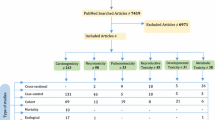Early-life environmental exposure to pesticides can cause reproductive, behavioral, and neurochemical defects in adulthood. Cypermethrin is a pyrethroid widely used throughout the world. Our study was aimed at elucidation of the effects of early-life exposure to cypermethrin on sexual behavior and plasma levels of pituitary/gonadal hormones in adult male mice. Cypermethrin in doses of 5, 10, or 15 mg/kg was i.p. administered to male pups from the 5nd to 10th postnatal day (PND). At PND 70, sexual behavioral phenomena (sniffing, following, mounting, and coupling) of adult male mice were tested using receptive female mice. After behavioral assessment, the animals were sacrificed, and plasma concentrations of testosterone, luteinizing hormone (LH), and follicle-stimulating hormone (FSH) were measured using the ELISA technique. Our results showed that cypermethrin-treated groups exhibited significantly suppressed sexual behavior (all assessed manifestations) and noticeably lower serum concentrations of testosterone and LH, when compared with the control group. The FSH level underwent insignificant changes.
Similar content being viewed by others
References
W. Aldridge, “An assessment of the toxicological properties of pyrethroids and their neurotoxicity,” CRC Crit. Rev. Toxicol., 21, 89-104 (1990).
J. Solati, R. Hajikhani, and R. T. Zaeim, “Effects of cypermethrin on sexual behaviour and plasma concentrations of pituitary-gonadal hormones,” Int. J. Fertil. Steril., 4, 23-28 (2010).
M. A. Asari, M. S. Abdullah, and S. Abdullah, “Effect of early neonatal exposure to deltamethrin on the purkinje cell number in rat cerebellum,” Malays. J. Med. Sci., 15, 14-21 (2008).
A. Gupta, R. Agarwal, and G. S. Shukla, “Functional impairment of blood-brain barrier following pesticide exposure during early development in rats,” Human Exp. Toxicol., 18, 174 (1999).
T. Schettgen, U. Heudorf, and H. Drexler, “Pyrethroid exposure of the general population is this due to diet,” Toxicol. Lett., 134, 141-145 (2002).
C. Lu, D. B. Barr, M. Pearson, et al., “A longitudinal approach to assessing urban and suburban children’s exposure to pyrethroid pesticides,” Environment. Health Perspect., 114, 1419 (2006).
R. Verschoyleand and W. Aldridge, “Structure-activity relationships of some pyrethroids in rats,” Arch. Toxicol., 45, 325-329 (1980).
D. M. Soderlund, “Molecular mechanisms of pyrethroid insecticide neurotoxicity: recent advances,” Arch. Toxicol., 1-17 (2011).
S. C. Joshi, B. Bansal, and N. D. Jasuja, “Evaluation of reproductive and developmental toxicity of cypermethrin in male albino rats,” Toxicol. Environ Chem., 93, 593-602 (2011).
S. Sahaand and A. Kaviraj, “Acute toxicity of synthetic pyrethroid cypermethrin to some freshwater organisms,” Bull. Environment. Contamin. Toxicol., 80, 49-52 (2008).
H. Viberg, W. Mundy, and P. Eriksson, “Neonatal exposure to decabrominated diphenyl ether (PBDE 209) results in changes in BDNF, CaMKII and GAP-43, biochemical substrates of neuronal survival, growth, and synaptogenesis,” Neurotoxicology, 29, 152-159 (2008).
T. J. Shafer, D. A. Meyer, and K. M. Crofton, “Developmental neurotoxicity of pyrethroid insecticides: critical review and future research needs,” Environ. Health Perspect., 113, 123 (2005).
U. Meyer, M. Nyffeler, B. Yee, et al., “Adult brain and behavioral pathological markers of prenatal immune challenge during early/middle and late fetal development in mice,” Brain, Behav., Immun., 22, 469-486 (2008).
M. Asiaei, J. Solati, and A. A. Salari, “Prenatal exposure to lps leads to long-lasting physiological consequences in male offspring,” Dev. Psychobiol., (2011).
S. C. Heinrichs, H. Min, S. Tamraz, et al., “Antisexual and anxiogenic behavioral consequences of corticotropin-releasing factor overexpression are centrally mediated,” Psychoneuroendocrinology, 22, 215-224 (1997).
U. Meyerand and J. Feldon, “Epidemiology-driven neurodevelopmental animal models of schizophrenia,” Prog. Neurobiol., 90, 285-326 (2010).
S. Bolden, J. Hambley, G. Johnston, and L. Rogers, “Neonatal stress and long-term modulation of GABA receptors in rat brain,” Neurosci. Lett., 111, 258-262 (1990).
T. Narahashi, “Nerve membrane ionic channels as the target of toxicants,” Arch. Toxicol., 9, Suppl. 3 (1986).
K. M. Crofton, L. W. Reiter, and R. B. Mailman, “Pyrethroid insecticides and radioligand displacement from the GABA receptor chloride ionophore complex,” Toxicol. Lett., 35, 183-190 (1987).
R. G. Paredesand and A. Agmo, “GABA and behavior: the role of receptor subtypes,” Neurosci. Biobehav. Rev., 16, 145-170 (1992).
A. Fernández-Guasti, G. Roldan-Roldan, and A. Saldivar, “Pharmacological manipulation of anxiety and male rat sexual behavior,” Pharmacol. Biochem. Behav., 35, 263-267 (1990).
S. T. Nett, J. C. Jorge-Rivera, M. Myers, et al., “Properties and sex-specific differences of GABAA receptors in neurons expressing γ1 subunit mRNA in the preoptic area of the rat,” J. Neurophysiol., 81, 192-203 (1999).
H. De Souza Spinosa, Y. M. A. Silva, A. A. Nicolau, et al., “Possible anxiogenic effects of fenvalerate, a type II pyrethroid pesticide, in rats,” Physiol. Behav., 67, 611-615 (1999).
D. E. Ray, D. Ray, and P. J. Forshaw, “Pyrethroid insecticides: poisoning syndromes, synergies, and therapy,” Clin. Toxicol., 38, 95-101 (2000).
A. Elbetieha, S. Da’as, W. Khamas, and H. Darmani, “Evaluation of the toxic potentials of cypermethrin pesticide on some reproductive and fertility parameters in the male rats,” Arch. Environment. Contamin. Toxicol., 41, 522-528 (2001).
M. Yousef, F. El. Demerdash, and K. Al. Salhen, “Protective role of isoflavones against the toxic effect of cypermethrin on semen quality and testosterone levels of rabbits,” J. Environ. Sci. Health, Part B, 38, 463-478 (2003).
Author information
Authors and Affiliations
Corresponding author
Rights and permissions
About this article
Cite this article
Solati, J. Alterations of sexual behavior and plasma concentrations of pituitary/gonadal hormones after early-life exposure of mice to cypermethrin. Neurophysiology 44, 229–233 (2012). https://doi.org/10.1007/s11062-012-9291-z
Received:
Published:
Issue Date:
DOI: https://doi.org/10.1007/s11062-012-9291-z




